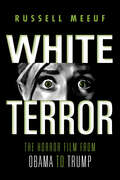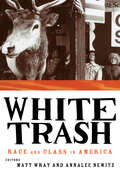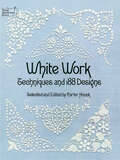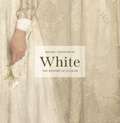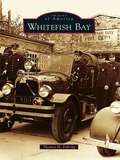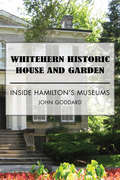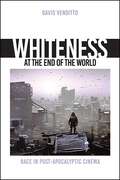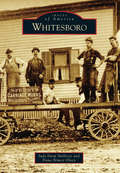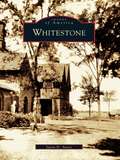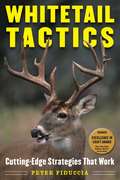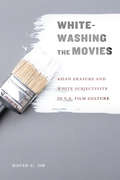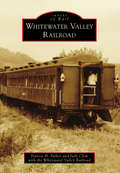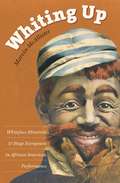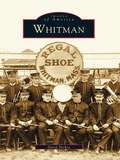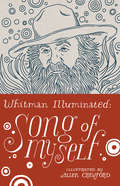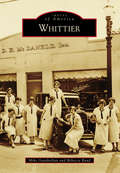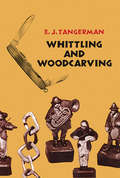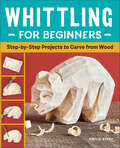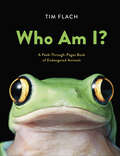- Table View
- List View
White Space Is Not Your Enemy: A Beginner's Guide to Communicating Visually Through Graphic, Web & Multimedia Design
by Kim Golombisky Rebecca HagenDESIGNING a website or brochure without an art background? Then step away from the computer and read this engaging conversational introduction to visual communications first. Written for the beginner, White Space Is Not Your Enemy is a practical graphic design and layout guide that introduces the concepts and practices necessary for producing effective visual communication across a variety of formats—from web to print. This beautifully illustrated full-color book covers all of the basics to help you develop your eye and produce evocative designs that work.Topics include: What is design? Predesign research & brainstorming The elements & principles of design Layouts for impact Getting along with type Choosing & using color Working with photos & illustrations Creating infographics Designing for web & social media
White Terror: The Horror Film from Obama to Trump
by Russell MeeufWhat kinds of terror lurk beneath the surface of White respectability? Many of the top-grossing US horror films between 2008 and 2016 relied heavily on themes of White, patriarchal fear and fragility: outsiders disrupting the sanctity of the almost always White family, evil forces or transgressive ideas transforming loved ones, and children dying when White women eschew traditional maternal roles. Horror film has a long history of radical, political commentary, and Russell Meeuf reveals how racial resentments represented specifically in horror films produced during the Obama era gave rise to the Trump presidency and the Make America Great Again movement. Featuring films such as The Conjuring and Don't Breathe, White Terror explores how motifs of home invasion, exorcism, possession, and hauntings mirror cultural debates around White masculinity, class, religion, socioeconomics, and more. In the vein of Jordan Peele, White Terror exposes how White mainstream fear affects the horror film industry, which in turn cashes in on that fear and draws voters to candidates like Trump.
White Trash: Race and Class in America
by Annalee Newitz Matt WrayFirst published in 1997. Routledge is an imprint of Taylor & Francis, an informa company.
White Work: Techniques and 188 Designs
by Carter HouckIn dozens of countries and in hundreds of varieties, the venerable craft of white work has become a byword for the ultimate form of needlework elegance. Its 3,000-year history encompasses every conceivable form of garment and decorative linen, from peasant blouses to papal vestments and the bridal gowns of queens; it appears in many guises as the favored embroidery of needleworkers from Denmark to South Africa, from England to the Philippines.Unfortunately, white work has frequently been neglected in the United States because of its underserved reputation as a difficult form of embroidery -- the type of work that, as author Carter Houck states, is never seen "beyond the glass cases of a museum." In reality white work can be performed at all levels of expertise; even more important, Ms. Houck shows that superb results can be achieved without laborious practice and prodigious technique. From these pages white work emerges as a vibrant and continually evolving form of contemporary embroidery that is both beautiful in itself and valuable for its myriad uses.Ms. Houck assumes no previous knowledge of white work and provides complete information on materials, pattern-transferring techniques, and instructions and diagrams for over 20 stitches: the simple chain stitch and running stitch; satin stitches and French knots; and more difficult "virtuoso" techniques like the Star and Shadow.Following the instructions are 40 pages of magnificent patterns, including florals, repeats, abstract designs, spot and corner decorations in a wide variety of sizes and moods, and two complete sets of alphabets for use as monograms. For each design Ms. Houck has suggested a stitch or stitches that produce optimal effects. As a result, the book acts as a self-contained guide to white work that can transform blouses, cuffs, collars, scarves, place settings, curtains, or any embroidery medium into treasures of heirloom quality.
White and Faded: Restoring Beauty in Your Home and Life
by Janet Parrella-Van Den BergThe only thing more beautiful than home transformation is personal transformation. Bring new life into your home and your soul through the gorgeous photography, inspiring story, and creative design ideas from Janet Parrella-Van Den Berg, founder of popular UK brand White & Faded. Journey through these hope-filled pages, and discover the hidden beauty in your own home and life.In White & Faded, Janet Parrella-Van Den Berg takes you on a stunning photographic tour through her restored English homes as she invites you into her personal journey of restoring her own sense of value and purpose—and reveals how you can do the same.So what is White & Faded? As Janet explains, she loves white things as a culmination of all colors and a representation of new mercies. And she loves faded things, such as cast-aside furniture, as a reminder that even what is painful or imperfect can be repurposed to reveal hidden beauty. Janet gives insights into both the literal and metaphorical aspects of white and faded as she draws on her decades of experience to offer:Full-color photography of restored English country homes, including a 1767 Georgian rectory in Kent and a home originally built in 1500Practical restoration tips—from large-scale homes to smaller antiquesFresh decorative ideas you can adapt to your own style, home, and season of lifeFun inspiration—from antique to modern—ideal for fans of HGTV and Magnolia NetworkInspiration to incorporate a touch of seasonal charm throughout the yearHow to make white work with kids and pets Janet's own remarkable story of trauma, love, and rediscovered identity How will you create a place in your life where you feel loved, find healing, and discover new treasures? Sometimes seeing the past through new eyes gives hope for the future—and looking ahead can be a beautiful way to come home.
White: The History of a Color
by Michel PastoureauFrom the acclaimed author of Blue, a beautifully illustrated history of the color white in visual culture, from antiquity to todayAs a pigment, white is often thought to represent an absence of color, but it is without doubt an important color in its own right, just like red, blue, green, or yellow—and, like them, white has its own intriguing history. In this richly illustrated book, Michel Pastoureau, a celebrated authority on the history of colors, presents a fascinating visual, social, and cultural history of the color white in European societies, from antiquity to today.Illustrated throughout with a wealth of captivating images ranging from the ancient world to the twenty-first century, White examines the evolving place, perception, and meaning of this deceptively simple but complex hue in art, fashion, literature, religion, science, and everyday life across the millennia. Before the seventeenth century, white’s status as a true color was never contested. On the contrary, from antiquity until the height of the Middle Ages, white formed with red and black a chromatic triad that played a central role in life and art. Nor has white always been thought of as the opposite of black. Through the Middle Ages, the true opposite of white was red. White also has an especially rich symbolic history, and the color has often been associated with purity, virginity, innocence, wisdom, peace, beauty, and cleanliness.With its striking design and compelling text, White is a colorful history of a surprisingly vivid and various color.
Whitefish Bay
by Thomas H. FehringThe abundance of whitefish in the Lake Michigan bay that frames this village gave it its name. The whitefish also helped feed the appetites of patrons of the resorts that once graced the community. Whitefish Bay quickly grew away from fishing and resorts to become the "Gold Coast" village north of Milwaukee. Nestled close enough to the city to allow an easy work commute, yet far enough away to provide an attractive community atmosphere, Whitefish Bay became a desirable location for families to put down roots. Stately homes went up alongside early farmhouses. Stores and other vibrant commercial enterprises quickly followed along with schools, churches, clubs, and organizations that continue to provide residents with a strong sense of community.
Whitehall (Images of America)
by William FloodThe city of Whitehall, skirting the eastern edge of Columbus, Ohio, is an undiscovered treasure of postwar America. The Lustron Corporation, based in Whitehall, lays claim to the origins of the prefabricated housing industry. The nation's first shopping center, the Town and Country, was built in the village in the late 1940s. The National Road passes through Whitehall, which helped create businesses offering lodging, meals, and entertainment on par with those along the storied Route 66. Images of America: Whitehall also pays homage to one of the most beloved tiki restaurants ever to grace the country: the famed Kahiki. This chronicle seeks to honor the amazing history of the "City of Pride."
Whitehall and Coplay
by Martha Capwell FoxWhen the first German, Huguenot, and Scotch-Irish settlers arrived in what is now Whitehall Township nearly three hundred years ago, their lives were fraught with peril. Some of the first families were nearly wiped out in raids during the French and Indian War. After the United States was established, the township settled into a long tranquil farming period, which lasted until the arrival of iron and the iron horse in the 1850s. Then, the Lehigh Valley became the cradle of the Industrial Revolution. Communities such as Egypt, Hokendauqua, Coplay, and Fullerton sprang up around iron mills, cement plants, and railroads. The new industries brought entrepreneurs, innovators, and immigrants to Whitehall and Coplay, changing the face of the township in many ways that are still visible today.
Whitehern Historic House and Garden: Inside Hamilton's Museums
by John GoddardInside Hamilton’s Museums helps to satisfy a growing curiosity about Canada’s steel capital as it evolves into a post-industrial city and cultural destination. In this special excerpt we visit Whitehern historic home and garden, which comes with three generations' worth of family possessions — everything from antique furniture to paintings, photographs, diaries, letters, and old toys. John Goddard takes us on a detailed tour of the historic home, providing fascinating historical background and insight into the McQuesten family secrets.
Whiteness at the End of the World: Race in Post-Apocalyptic Cinema (SUNY series, Horizons of Cinema)
by David VendittoThe use of Christian apocalyptic myths has changed significantly over the centuries. Initially used by genuinely disenfranchised groups, they are used today as a response to more egalitarian treatment of minorities in American society. The apocalyptic framework allows the patriarchy to frame itself as the victim who must restore America to a past where white male power went uncontested. This kind of white anxiety over increasing minority rights frequently manifests itself in contemporary apocalyptic media, which often depicts a white male hero facing a wide array of threatening "Others." Taking a unique look at the parallels between apocalypticism and American frontier mythology, as well as conspiracy theories and the post-apocalyptic obsession with repurposed objects, Whiteness at the End of the World analyzes many well-known films from the past fifty years, from Planet of the Apes to I Am Mother. It offers unique, clearly presented insights into recurring patterns that appear in an extraordinarily ubiquitous genre that has only increased in popularity, and whose themes of racial anxiety are increasingly pertinent in our increasingly contentious political climate.
Whitesboro
by Dana Nimey Olney Judy Harp MallozziThe fertile farmlands of the Mohawk Valley brought the first settlers to Whitestown, founded by Hugh White in 1784. Abundant water was available to service mills and to provide a means for shipping goods from the existing knitting mills, cheese factories, iron works, and lumberyards of Whitesboro, a village of Whitestown. Irish immigrants settled into Whitesboro after building the Erie Canal, while German immigrants brought their carpenter talents to build furniture, such as the famous Quigley rolltop desk. The Dutch sought out Wybo E. Wind, the Dutch baker who employed many in his bakery, and because of the large number of Welsh immigrants in Remsen, there was a big spillover into Whitesboro. Among the first things sought by those visiting the area is Whitesboro's diverse cuisine, boasting some of the best Italian, Greek, and Lebanese dishes, all brought by immigrants. Whiteboro's proximity to the Adirondacks allows residents to enjoy camps, summer homes, swimming, and winter activities. The rolling hills and beautiful scenery are part of the charm that still attracts people to the area today.
Whitestone
by Jason D. AntosWhitestone was named after a large limestone boulder found in 1645 by the Dutch on the virtually flat seashore. The Dutch recognized the great potential to establish the town as a major trading port due to its location by the East River. They purchased the town from the Matinecock tribe, who had been living on the fertile land, for the price of one ax for every 50 acres. The town prospered, and the population grew. In 1898, Whitestone became a part of New York City, and the area experienced a real estate boom. Beautiful estates and private homes sprung up overnight. Celebrities from the golden age of cinema, such as Mary Pickford, Charlie Chaplin, and Rudolph Valentino, established homes in the area. After becoming a major hub for the Long Island Railroad, Whitestone became the home of the famous Whitestone Bridge, which is regarded as the greatest suspension bridge ever built. Through historic photographs, Whitestone chronicles this town's transformation from a quiet Dutch settlement to a massive urban center.
Whitetail Tactics: Cutting-Edge Strategies That Work (Lyons Press Ser.)
by Peter J. FiducciaWhitetail hunters familiar with Peter Fiduccia’s books, articles, seminars, and television shows know that he offers straightforward, practical, cutting-edge deer hunting advice and down-to-earth commentary. His observations and analysis will help take anyone’s deer hunting skills to the next level.Here, Fiduccia shares his extensive knowledge of whitetail behavior. His time-tested advice is intended to benefit those who "hunt deer under the real-world conditions of heavily hunted areas,” says Fiduccia. If you hunt deer on pressured lands, these tactics are meant to give you an edge over other hunters and help you get a buck when others can’t.Whitetail Tactics contains no-nonsense strategies and subjective insights into many aspects of deer hunting that are rarely discussed. Throughout these pages, Fiduccia shares a lifetime of successful deer hunting experiences about the animal he has hunted throughout North America. This instructive and entertaining book is filled with color photos that will both inform and entertain readers.Passionately expressed, the author shares his most guarded secrets and progressive strategies to help all deer hunters-from seasoned veterans to novices-consistently take mature bucks in heavily hunted areas. Whitetail Tactics is a must-have book for your deer hunting library.
Whitewashing the Movies: Asian Erasure and White Subjectivity in U.S. Film Culture
by David C OhWhitewashing the Movies addresses the popular practice of excluding Asian actors from playing Asian characters in film. Media activists and critics have denounced contemporary decisions to cast White actors to play Asians and Asian Americans in movies such as Ghost in the Shell and Aloha. The purpose of this book is to apply the concept of “whitewashing” in stories that privilege White identities at the expense of Asian/American stories and characters. To understand whitewashing across various contexts, the book analyzes films produced in Hollywood, Asian American independent production, and US-China co-productions. Through the analysis, the book examines the ways in which whitewashing matters in the project of Whiteness and White racial hegemony. The book contributes to contemporary understanding of mediated representations of race by theorizing whitewashing, contributing to studies of Whiteness in media studies, and producing a counter-imagination of Asian/American representation in Asian-centered stories.
Whitewater
by Fred G. KraegeThe city of Whitewater was named for the soft, white clay that lined the stream flowing through the area. Later it claimed the motto "the Banner Inland City of the Midwest" and, after that, "Whitewater, the City Beautiful" for its stately homes and large, graceful trees. Samuel Prince, the first settler, erected a cabin on his claim of 60 acres in 1837; a gristmill, sawmill, paper mill, and numerous stores were soon established in this rich agricultural area. The railroad came, and the manufacturing of the Esterly Grain Harvester and the Whitewater Wagon made Whitewater an industrial town. In 1868, the state's second normal school--later the University of Wisconsin-Whitewater--located here, further changing the town's character.
Whitewater Valley Railroad (Images of Rail)
by Whitewater Valley Railroad Francis H. Parker Judy ClemThe Whitewater Valley Railroad is a historic line in scenic southeastern Indiana. It was completed to Connersville in 1867, linking the towns of the Whitewater Valley to Cincinnati over the former towpath of the Whitewater Canal (1836-1862). Originally named the White Water Valley Railroad, the line went through several name changes before being absorbed by the Cleveland, Cincinnati, Chicago & St. Louis (the "Big Four") in 1890 and later by the New York Central, the parent company of the Big Four. After merging with the Pennsylvania Railroad in 1968, the line became the Penn Central before closing in 1972 between Brookville and Connersville. It was slated for abandonment when a group of volunteers stepped in to create the Whitewater Valley Railroad, which ran its first tourist passenger trains in 1974. The nonprofit volunteer organization celebrates its 40th anniversary of operations in 2014.
Whiting Up
by Marvin McallisterIn the early 1890s, black performer Bob Cole turned blackface minstrelsy on its head with his nationally recognized whiteface creation, a character he called Willie Wayside. Just over a century later, hiphop star Busta Rhymes performed a whiteface supercop in his hit music video "Dangerous." In this sweeping work, Marvin McAllister explores the enduring tradition of "whiting up," in which African American actors, comics, musicians, and even everyday people have studied and assumed white racial identities. Not to be confused with racial "passing" or derogatory notions of "acting white," whiting up is a deliberate performance strategy designed to challenge America's racial and political hierarchies by transferring supposed markers of whiteness to black bodies--creating unexpected intercultural alliances even as it sharply critiques racial stereotypes. Along with conventional theater, McAllister considers a variety of other live performance modes, including weekly promenading rituals, antebellum cakewalks, solo performance, and standup comedy. For over three centuries, whiting up as allowed African American artists to appropriate white cultural production, fashion new black identities through these "white" forms, and advance our collective ability to locate ourselves in others.
Whitman (Images of America)
by David HickeyMost commonly known as the home of the world-famous Toll House cookie, Whitman has a rich history that goes well beyond the cookie jar. Centrally located between Boston and Cape Cod, the town played a significant role in the formative years of the country. Early industries included various mills, foundries, and tack factories; later industry was defined by prosperous shoe manufacturing, as Whitman was home to many of the country's largest shoe factories. Whitman takes the reader on a trolley ride through the quaint center, which still evokes that small-town feeling, and the town park, which was designed by legendary architect Frederick L. Olmstead. Through more than two hundred photographs, this nostalgic tour shows the schools, churches, commerce, and the lives of Whitman residents, all of which bring back memories of a simpler time.
Whitman Illuminated: Song of Myself
by Walt Whitman Allen CrawfordWalt Whitman's iconic collection of poems, Leaves of Grass, has earned a reputation as a sacred American text. Whitman himself made such comparisons, going so far as to use biblical verse as a model for his own. <P><P>So it's only appropriate that artist and illustrator Allen Crawford has chosen to illuminate-like medieval monks with their own holy scriptures-Whitman's masterpiece and the core of his poetic vision, "Song of Myself." Crawford has turned the original sixty-page poem from Whitman's 1855 edition into a sprawling 234-page work of art. The handwritten text and illustrations intermingle in a way that's both surprising and wholly in tune with the spirit of the poem-they're exuberant, rough, and wild. Whitman Illuminated: Song of Myself is a sensational reading experience, an artifact in its own right, and a masterful tribute to the Good Gray Poet.
Whitman Illuminated: Song of Myself
by Walt Whitman Illustrated by Allen CrawfordContaining numerous contemporary images by leading photographers, this indispensable manual concerning wedding portraits explains posing fundamentals as well as how to create a flattering, feature-specific photograph--one that focuses on the head, shoulders, arms, legs, or torso--in different levels of close-ups, from head-shots to full-lengths.
Whittier (Images of America)
by Michael Garabedian Rebecca RuudWhen Quaker colonists arrived in Southern California in 1887 to establish their "ideal city of dreams" between the San Gabriel River and the base of the Puente Hills, this land already had a storied past. It was once a place where native Tongvans gathered, the site of Spanish land grant holder Manuel Nieto's rancho, and home to the mansion of the last governor of Alta California, Pío Pico. Named by the early settlers after the abolitionist poet, "Ye Olde Friendly Towne of Whittier" grew from a small colony of Quaker pioneers to a bustling center for the production of citrus, walnuts, and avocados. After incorporation in 1898, Whittier also became a flourishing suburb connected to Los Angeles via the Pacific Electric trolley; the home of Whittier College, celebrated for its academics and the mascot Johnny Poet; and home to several notable Americans, including the 37th president of the United States.
Whittling and Woodcarving
by E. J. TangermanThroughout the ages one of the most popular ways to direct the creative urge has been whittling or woodcarving. In this volume Mr. Tangerman, one of America's foremost authorities and craftsmen, whose articles in craft magazines have taught and inspired millions, presents a full and thorough introduction to this entertaining art form. With this book, which is one of the few works that bridge the gap between whittling and serious carving, a beginner who is moderately handy can whittle or carve scores of useful objects, toys for children, gifts, or simply pass hours at applying his ingenuity to wood.Beginning with a history of whittling and woodcarving, the book progresses gradually and easily. The first chapters supply background information on different woods, their proper selection and possible uses, selection and care of knives, and ways of using tools, including grips, types of strokes and cuts, and simple exercises. The following chapters cover rustic work, flat toys and windmills, puzzles, chains, nested spheres, fans, joints, modeling ships in bottles, and caricatures. The second half of the book covers carving proper and describes simple lines, woodcuts, low-relief pierced designs, sculpture in the round, inlay and marquetry, lettering, indoor and outdoor decorations, and styles. The final chapter describes finishing, repairs, and the care of tools. The wide range of illustrations includes both hundreds of beautiful wood objects from the great art of the world and hundreds of modern projects, many of which are contest winners."Mr. Tangerman guides actual working, but his tone of direct address, such as a teacher would use in speaking to a pupil or a class of intelligent pupils, makes it easy as well as instructive reading." -- New York Herald Tribune Books. "A fascinating book, giving many suggestions of what to make and how to make it, ranging from simple things to intricate ones." -- Horn Book Magazine.
Whittling for Beginners: Step-by-Step Projects to Carve from Wood
by Emilie RigbyYour go-to guide for getting started with whittling!Are you thrilled by the thought of hand carving wood into rugged, rustic pieces to decorate your space or give as gifts? Then you've come to the right place. Whittling for Beginners walks you through the tools, techniques, and materials you need to whittle everything from a butter spreader to a garden gnome to a full chess set!Beginner wood carving — Start from scratch with guidance on choosing your knives, sourcing your wood, and whittling safely.Learn the fundamentals — Find step-by-step instructions for the most common cuts and finishing techniques, so you can build the basic skills to whittle almost anything.24 woodworking projects to try —This whittling book includes 24 projects that progress in complexity along with your knowledge—begin with a super-simple magic wand and work your way up to detailed animal figurines!Pick up a relaxing new hobby today with this wood carving book for beginners.
Who Am I?: A Peek-Through-Pages Book of Endangered Animals
by Tim FlachWho is that peeking through the page? Is it a giant panda munching on bamboo? Or perhaps a yellow-eyed tree frog hiding in a tropical forest? Who Am I? uses clever riddles and stunning images by esteemed photographer Tim Flach (taken from his Abrams adult book Endangered) to introduce ten vital species-at-risk to readers. With its engaging and timely message, this beautifully crafted picture book is perfect for the youngest animal enthusiasts.

